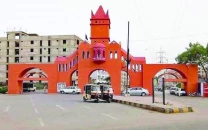'EIA public hearings have become a meaningless formality'
Speakers discuss environmental issues of metropolis at fifth Karachi Conference

PHOTO: EXPRESS
As building projects continue to be approved at a fast pace without any checks and balances, the concept of environmental impact assessments (EIA) for these projects is being relegated to the background at an even faster pace.
Development poses environmental hazards: experts
Architect Arif Belgaumi, who has an interest in urban and environmental issues, spoke on Saturday in detail about the environmental cost to citizens and the process of such development while presenting his paper, 'Fallacies in the Procedures of Environmental Protection Agencies', on the second day of the Fifth Annual Karachi Conference at the Arts Council of Pakistan, Karachi.
"When our actions fall out of sync with the environment, it affects our wellbeing. All actions must be executed with an intent and understanding of the consequences," Belgaumi said, tracing a brief history of the environmental laws in Pakistan.
The Pakistan Environmental Protection Act, passed in 1997, was a law believed to have empowered citizens, he said. With little change, it was replaced by the Sindh Environmental Protection Act, 2014.
No more high-rise buildings: Karachi's construction industry to bear the brunt of SBCA's ban
Over the years, the way in which environmental laws are applied, and in fact, our whole approach to environment assessment and monitoring, has revealed an attitude of apathy and genuine disregard for environmental concerns and research and analysis, Belgaumi highlighted.
Explaining the process of an EIA, including the public hearing for a proposed development project, he pointed out that the public hearings and assessment has become a meaningless formality which serves no real purpose in the improvement of the environmental condition of the city.
The EIA report is required to be readily available to the public, he said. There is a gross absence of urban monitoring, so the only opportunity given to the public to raise their concerns - a public hearing - is an inaccessible platform to give the common man a false sense of involvement in the decision-making process, believed Belgaumi.
SC dismisses ABAD's request to lift ban on high-rise buildings
"Usually, the EIA notices for hearings are published in unknown newspapers. One would only come across a notice if they were actively searching for it," he said.
Hearing locations are remote, often inaccessible, he said, giving an example of one EIA hearing that was held in Hyderabad for a project based in Karachi. Such acts ensure the people do not come to give their feedback, said Belgaumi
This is how the Sindh Environment Protection Agency discourages people from giving feedback on the impact on the environment for any new project in Karachi, Belgaumi noted, saying that there has never been meaningful feedback, yet most projects are approved as submitted.
"Only multi-storeys with 15 floors or more made over a minimum of 2,000 to 3,000 square yard plots are required to go through the EIA process," revealed Belgaumi. Therefore, a vast majority of the multi-storey buildings are exempted from going through an approval process.
The dark side of the apartment boom in Karachi
The construction of high-rise buildings is leading to overcrowding and a decline in the quality of life for people, he said, urging for the need to assess the consequences of a development project before implementation.
"Public presence is necessary. If only the people sitting here today can show up to a hearing it would scare EIA!" commented urban planner and architect Arif Hasan, who served as the discussant of the session.
Hasan shared that the establishment of environmental courts may ease the current situation of environmental neglect.
There is nothing wrong with real estate development if all stakeholders come together, said architect Syed Yawar Abbas Jilani, who presented his paper, 'The Changing Skyline of Karachi'.
He stressed the importance of having an autonomous planning and development authority for which understands the dynamics of the city.
The boom in the construction of high-rise buildings did not happen because of any change in urban policy, but due to compulsions of market forces, Jilani highlighted, explaining that the middle class wanted to live closer to their workplace and decrease their commute.
No more high-rise buildings, says judicial commission
"However, we need to learn how to control these changes in a manner suiting the needs of the city and its people," he said.
He said that Karachi is not just one entity but several entities who do not talk to each other. "We are like headless chickens," he said, emphasisng the need for various development authorities and groups to plan uniformly.
Meanwhile engineer Rehan Zamin, who presented a paper, 'Why Does Karachi need a BRT? Maximising the Benefits; Minimising the Impacts', discussed the transport infrastructure of the city, which he believed is in bad shape. He provided insight into what the city's mass transit system - Bus Rapid Transit - may look like after completion and how it will be designed to ensure it suits the city's needs. His presentation outlined not only the positive, but also the adverse impacts the various BRT projects can have. He also spoke on the different approaches that can be used to mitigate the negative impacts.
The conference ends today.



















COMMENTS
Comments are moderated and generally will be posted if they are on-topic and not abusive.
For more information, please see our Comments FAQ